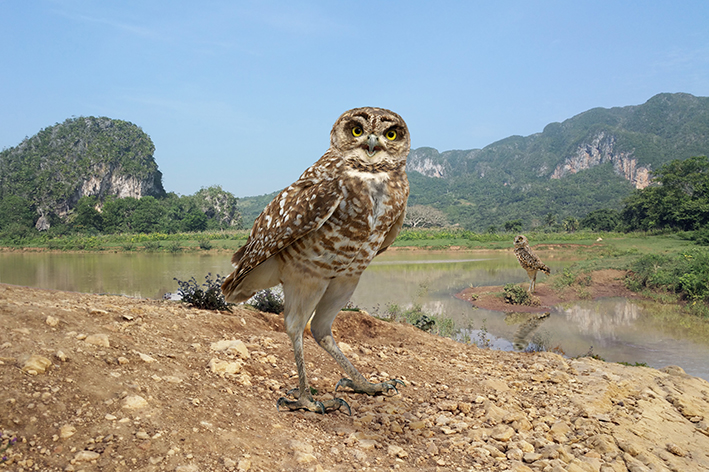(Full article from RATS Tales October 2020)
Thousands of years ago—before cane and tobacco, before Castro, even before the Buena Vista Social Club—Cuba was a very different place. Among a bizarre bestiary of shrew-like solenodons with venomous bites, small-to-medium ground sloths, and flightless waterbirds, all the dominant predators were raptors. A buteonine hawk as large as a golden eagle patrolled the skies; a condor-sized vulture may have taken live prey as well as carrion; and at least five species of giant owls terrorized the sloths and rodents.

Ornimegalonyx oteroi, with short, apparently nonfunctional wings and long legs, stood three feet tall and weighed an estimated 20 pounds. It may have chased down its victims on foot or attacked from ambush. Also known from Pleistocene fossil remains are three barn owls: one (Tyto noeli) larger than the living North American species, the other two (T. pollens and the recently described T. cravesae) near the size of Ornimegalonyx. A fifth owl, Bubo osvaldi, was related to the North American great horned owl and the Eurasian eagle owl but bigger than either. If the world ever needs monster movies again, these birds would be a lot scarier than the giant mutant rabbits of Night of the Lepus.
Although other Caribbean islands lacked Cuba’s raptorial diversity, supersized barn owls appeared elsewhere. Hispaniola, now divided between Haiti and the Dominican Republic, had T. ostologa, which approached the largest Cuban owls in size and probably preyed on the island’s endemic monkeys. Some of the big owls must have flown well enough to disperse from island to island. Fossils of Cuba’s T. noeli have been found on Jamaica and on Barbuda in the Lesser Antilles. T. pollens also occurred on Little Exuma and New Providence Islands in the Bahamas and has a curious place in Bahamian folklore: It’s been speculated that the local legend of the chickcharneys, beings both humanlike and birdlike that lived in the treetops, may have been based on T. pollens, perhaps on traditions passed down from the indigenous Lucayan-Taino people.
Why the big owls? All the islands where their remains have been found were well stocked with prey, including a range of guinea-pig-like hutias. If the larger adult sloths, some sheep-sized, were unlikely targets, younger individuals and smaller species would have been vulnerable. The late Cuban naturalist Oscar Arredondo, an actor and singer who became known as “the father of Cuban vertebrate paleontology,” mentioned “the hypothesis that gigantism in Antillean barn owls is attributable to insular evolution from smaller species that responded to the great abundance of food and the lack of competition from carnivorous mammals.”* In his book Island Life, biologist Sherwin Carlquist offered a similar explanation: “Lacking large mammals, Cuba evolved birds to take their places. Without danger of being captured by, for example, a large cat, an owl could ‘afford’ to be flightless.”
The youngest Ornimegalonyx remains have been dated to about 11,700 years ago. The other mega-owls of Cuba, Hispaniola, Jamaica, Barbuda, and (chickcharney tales notwithstanding) most likely the Bahamas, had probably gone extinct by 6,000 years ago, outlasting the megafauna of North America by several millennia. Human hunters may have deprived them of their prey base, although some of the hutias are still around (one species is particularly abundant at Guantanamo). The owls’ remains were preserved in the islands’ caves and sinkholes, along with the pellets they coughed up—a boon to scientists attempting to understand ancient ecosystems.
As it happens, the age of giant Caribbean owls echoed another evolutionary development much earlier and half a world away, when enormous barn owls lived on several Mediterranean islands. From 12 to 4 million years ago, Italy’s Gargano Peninsula, the spur on the boot heel, was an island inhabited, like Cuba, by multiple barn owl species. One was the size of modern barn owls; Tyto robusta was larger; T. gigantea was bigger than living eagle owls. Their prey would have included pikas, hamsters, and dormice of unusual size, and, like the Caribbean owls, they had no competition from dogs, cats, or other carnivores.
Contemporaneous giant barn owls inhabited Sicily and Mallorca. Whatever caused their extinction, they were gone long before humans showed up. The phenomenon of closely related but different-sized raptor species sharing a habitat and divvying up the available prey is not that unusual, as witness North America’s sharp-shinned and Cooper’s hawks. Outsized owls have also evolved on continents; bits of the skull and leg bones of a huge, still unnamed species turned up in Bartow County, Georgia, northwest of Atlanta. But the recurrent appearance of huge and/or flightless owls on islands is something else again. It suggests the patterns shown by anole lizards in the West Indies, spiders in Hawai’i, stickleback fish in the Pacific Northwest, and cichlid fish in the Rift Valley lakes of Africa, with similar assemblages of species evolving on island after island, in lake after lake. To paraphrase what Mark Twain is supposed to have said about history, evolution doesn’t repeat itself. But it sometimes seems to rhyme.
*from The Great Predatory Birds of the Pleistocene of Cuba (1976), translated by Storrs L. Olson
